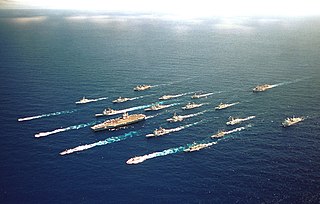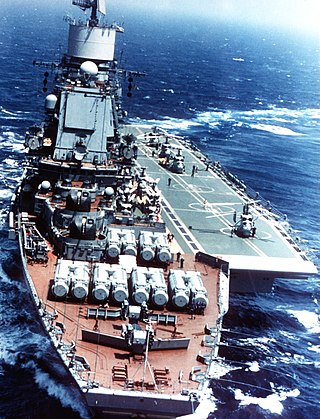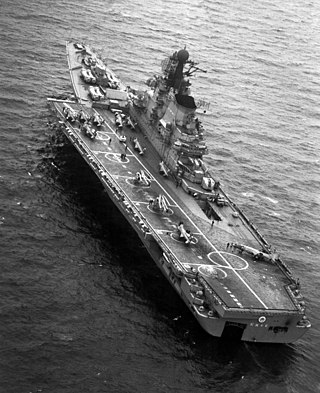
An aircraft carrier is a warship that serves as a seagoing airbase, equipped with a full-length flight deck and hangar facilities for supporting, arming, deploying and recovering shipborne aircraft. Typically it is the capital ship of a fleet, as it allows a naval force to project seaborne air power far from homeland without depending on local airfields for staging aircraft operations. Since their inception in the early 20th century, aircraft carriers have evolved from wooden vessels used to deploy individual tethered reconnaissance balloons, to nuclear-powered supercarriers that carry dozens of fighters, strike aircraft, military helicopters, AEW&Cs and other types of aircraft such as UCAVs. While heavier fixed-wing aircraft such as airlifters, gunships and bombers have been launched from aircraft carriers, these aircraft have not landed on a carrier due to flight deck limitations.

A carrier battle group (CVBG) is a naval fleet consisting of an aircraft carrier capital ship and its large number of escorts, together defining the group. The CV in CVBG is the United States Navy hull classification code for an aircraft carrier.

Príncipe de Asturias, originally named Almirante Carrero Blanco, was a light aircraft carrier and former flagship of the Spanish Navy. She was built in Bazán's Shipyards and delivered to the Spanish Navy on 30 May 1988.

The Wasp-class is a class of landing helicopter dock (LHD) amphibious assault ships operated by the United States Navy. Based on the Tarawa class, with modifications to operate more advanced aircraft and landing craft, the Wasp-class is capable of transporting almost the full strength of a United States Marine Corps Marine Expeditionary Unit (MEU), and landing them in hostile territory via landing craft or helicopters as well as providing air support via AV-8B Harrier II attack aircraft or F-35B Lightning II stealth strike-fighters. All Wasp-class ships were built by Ingalls Shipbuilding, at Pascagoula, Mississippi, with the lead ship, USS Wasp, commissioned on 29 July 1989. Eight Wasp-class ships were built, and as of April 2021, seven are in active service, as USS Bonhomme Richard was seriously damaged by fire on 12 July 2020, and subsequently decommissioned in April 2021.

The flight deck of an aircraft carrier is the surface from which its aircraft take off and land, essentially a miniature airfield at sea. On smaller naval ships which do not have aviation as a primary mission, the landing area for helicopters and other VTOL aircraft is also referred to as the flight deck. The official U.S. Navy term for these vessels is "air-capable ships".

Cavour is an Italian aircraft carrier launched in 2004. She is the flagship of the Italian Navy.

An anti-submarine warfare carrier is a type of small aircraft carrier whose primary role is as the nucleus of an anti-submarine warfare hunter-killer group. This type of ship came into existence during the Cold War as a development of the escort carriers used in the ASW role in the North Atlantic during World War II.

Dédalo was the first Spanish aircraft carrier and the second aviation ship in the Spanish Navy. She remained the fleet's flagship until Príncipe de Asturias replaced her. Dédalo was formerly the World War II-era light aircraft carrier USS Cabot, which was acquired from the United States in the 1960s.

Juan Carlos I is a multi-purpose aircraft carrier-landing helicopter dock (LHD) in the Spanish Navy. Similar in role to many aircraft carriers, the amphibious landing ship has a ski jump for STOVL operations, and is equipped with the McDonnell Douglas AV-8B Harrier II attack aircraft. The vessel is named in honour of Juan Carlos I, the former king of Spain.

A helicopter carrier is a type of aircraft carrier whose primary purpose is to operate helicopters. It has a large flight deck that occupies a substantial part of the deck, which can extend the full length of the ship like HMS Ocean of the Royal Navy (RN), or extend only partway, usually aft, as in the Soviet Navy's Moskva class or in the Chinese Navy's Type 0891A. It often also has a hangar deck for the storage and maintenance of rotorwing aircraft.

Vittorio Veneto was a helicopter cruiser that served with the Italian Navy. Originally intended to be a class of two ships specifically designed for anti-submarine warfare (ASW), only Vittorio Veneto entered into service in 1969, its sister ship Italia being cancelled. Vittorio Veneto was placed into reserve in 2003 and decommissioned in 2006. This ship has the same general layout as the smaller Andrea Doria-class helicopter cruisers, but with two elevators in the flight deck and the hangar below, rather than with the hangar as part of the superstructure. It was named for the decisive Battle of Vittorio Veneto which ended World War I on the Italian front.

The America class is a ship class of landing helicopter assault (LHA) type amphibious assault ships for the United States Navy (USN). The class is designed to put ashore a Marine Expeditionary Unit using helicopters and MV-22B Osprey V/STOL transport aircraft, supported by AV-8B Harrier II or F-35 Lightning II V/STOL aircraft and various attack helicopters. The first of these warships was commissioned by the U.S. Navy in 2014 to replace USS Peleliu of the Tarawa class; as many as eleven will be built. The design of the America class is based on that of USS Makin Island, the last ship of the Wasp class, but the "Flight 0" ships of the America class will not have well decks, and have smaller on-board hospitals to provide more space for aviation uses.

The aircraft cruiser is a warship that combines the features of the aircraft carrier and a surface warship such as a cruiser or battleship.

The McDonnell DouglasAV-8B Harrier II is a single-engine ground-attack aircraft that constitutes the second generation of the Harrier family, capable of vertical or short takeoff and landing (V/STOL). The aircraft is primarily employed on light attack or multi-role missions, ranging from close air support of ground troops to armed reconnaissance. The AV-8B is used by the United States Marine Corps (USMC), the Spanish Navy, and the Italian Navy. A variant of the AV-8B, the British Aerospace Harrier II, was developed for the British military, while another, the TAV-8B, is a dedicated two-seat trainer.

A carrier-based aircraft is a naval aircraft designed for operations from aircraft carriers. Carrier-based aircraft must be able to launch in a short distance and be sturdy enough to withstand the abrupt forces of launching from and recovering on a pitching deck. In addition, their wings are generally able to fold up, easing operations in tight quarters.

The LHD Trieste is a multi-purpose aircraft carrier-landing helicopter dock (LHD) of the Italian Navy. The ship replaced the aircraft carrier Giuseppe Garibaldi and is the largest vessel in the Italian fleet. It was ordered as part of the 2014–2015 naval program and was built at the Castellammare di Stabia shipyards of Fincantieri. On 7 December 2024, the ship was commissioned at the Italian Navy's base in Livorno.

The Italian Naval Aviation is the naval air component of the Italian Navy composed of around 2000 men and women and 69 aircraft and helicopters.

In aviation, a ski-jump is an upwardly curved ramp that allows a fixed-wing aircraft to take off from a runway that is shorter than the aircraft normally requires. By providing an upward vector from the ski-jump's normal force, the aircraft is launched at an elevated angle and lift-off can be achieved at a lower airspeed than that required for flat takeoff, as it allows the aircraft more time to continue accelerating while airborne after leaving the runway. Ski-jumps are commonly used to launch shipborne aircraft from aircraft carriers that lack catapults.

Admiral Giuseppe Cavo Dragone is an Italian naval officer, who served as Chief of the Defense Staff since 19 October 2021 to 3 October 2024. Prior to his assumption, he served as the Chief of Staff of the Italian Navy from 21 June 2019 to 19 October 2021, and as commander of the Joint Operations Command, and the Joint Special Forces Operations Headquarters.

Alpino(F 594) is a Carlo Bergamini-class frigate of the Italian Navy. Which in turn were developed by the FREMM multipurpose frigate program.


























